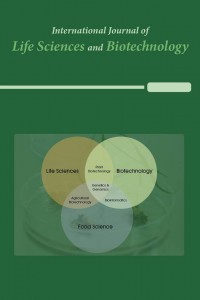The chronic toxicity studies of camellia seed oil containing tea saponins on mice blood and organs
The chronic toxicity studies of camellia seed oil containing tea saponins on mice blood and organs
Camellia seed oil, , tea saponins, , mice, , blood, , organs, hemogram, , histology,
___
- References 1. Pu, E. Y. Studies on stability of liquid/liquid dispersions: Theory and practice [D]. Zrich: Switzerland Union Higher Industry College Doctor Degree Thesis, 1995.
- 2. Wu, X., Huang Y., Xie Z. Health functions and prospective of Camellia oil. J. Food Sci. Technol., 2005, (5): 94-96.
- 3. Hu, J.B. and Yang G.L. Physiochemical characteristics, fatty acid profile and tocopherol composition of the oil from Camellia oleifera Abel cultivated in Henan, China. GRASAS Y ACEITES, 2018, 69 (2): 1-9; https://doi.org/10.3989/gya.1224172.
- 4. Wu, H., Li C., Li Z., Liu R., Zhang A., Xiao Z., Ma L., Li. J. and Deng S. Simultaneous extraction of oil and tea saponin from Camellia oleifera Abel. Seeds under subcritical water conditions. Fuel Proc. Tech., 2018. , 174: 88–94. https://doi.org/10.1016/j.fuproc.2018.02. 014.
- 5. Qiu, H., Chen, D., Liu, Y.,Wu, X., Ren, R., Cheng, Q. Study on anti atherosclor-esis effects of daidai flavones dropping pills on hyperlipidemia rats. Chin. J. Mod. Appl. Pharm. 2011, 28: 597–601.
- 6. Ling T., Min F., Li Bing, Chen Yuelong, Shi Liying, Wang Yong-qi. Research progress of Camellia oleifera saponin. J. Central pharm, 2008, 03:( 330-333.
- 7. Hostettmann, K. and Marston A. Saponins Cambridge: Cambridge University Press. p. 3ff. ISBN 978-0-521-32970-5. OCLC 29670810, 1995. https://doi.org/10.1017/ CBO 9780511565113.
- 8. Xu D. J., Yan, S. Experimental animals and food safety. Chinese J. comp., 2011, Med. Z 1: 27-29.
- 9. Yuan, X.Z., Meng, Y.T., Zeng, G.M, Fang, Y.Y., Shi. J.G. Evaluation of tea-derived bio-surfactant on removing heavy metal ions from dilute wastewater by ion flotation. J. Colloids Surf. A: Physicochem. Eng. Asp. , 2007, 317:1-3, 256-261.
- 10. Ainwale, S.S., Chipade, V.D., Dewani, A.P., Shiradkar, M.R., Bakal R.L., Chandewar A.V. Application of Chromatography in Phytochemistry. International Journal of Universal Pharmacy and Life Sciences 2012, 2(2): 394-414.
- 11. Płotka-Wasylka, J., Szczepanska, N., de la Guardia, M., Namiesnik, J. Miniaturized solid-phase extraction techniques. Trends Anal. Chem., 2015, 73: 19–38. https://doi.org/10.1016/j.trac.2015.04.026.
- 12. NIH, 1997. https://grants.nih.gov/grants/olaw/Guide-for-the-Care-and-use-oflaboratory- animals. Pdf.
- 13. Abliz, A., Aji, Q., Abdusalam, E., Sun, X., Abdurahman, A., Zhou, W., Moore, N., Umar, A. Effect of Cydonia oblonga Mill. Leaf extract on serum lipids and liver function in a rat model of hyperlipidaemia. J. Ethnopharm. 2014, 151: 970–974. https://doi.org/10.1016/j.jep.2013.12.010.
- 14. Chen B., Umar A., Tohti I., Tian S., Imam G. Experimental study on regulation of lipid metabolism by extract of Ocimum basilicum L. in rats with hyper-lipidemia. China Tradit. Pat. Med, 2009, 31: 844–847.
- 15. Chen Y., Du T., Zhao Z., Huang X., Zeng X. Effect of compound cur-cumin microcapsules on serum lipids and liver pathology of hyper-lipidemic rats. Chin. Tradit. Pat. Med, 2012, 34: 1025–1029.
- 16. Ghule B.V.,Ghante M.H., Saoji A.N.,Yeole P.G. Anti hyper- lipidemic effect of the methanolic extract from Lagenaria siceraria stand. Fruit in hyperlipidemic rats. J. Ethnopharmacol, 2009, 124: 333–337. https://doi.org/10.1016/j.jep.2009.04.040.
- 17. Giovanni M., Roberto G., Maurizio C. Recent insights into hepatic lipid metabolism in non-alcoholic fatty liver disease (NAFLD). Prog. Lipid Res, 2009, 48: 1–26.
- 18. Liu F., Chen H., Zong M., Wei L., Liu C. Effects of total saponins of medicago- sativa on blood lipid metabolism in rats with experimental hyperlipidemia. China J. Exp. Tradit. Med. Formul, 2011, 17: 211–214.
- 19. Chun, C., Jizhong, Y., Feng Z., Haitao H., Xuxia Z. Normal light activity and applied research saponin Camellia progress. J. Zhejiang Agri. Sci., 2011, 03: 593-598.
- 20. Shen, T-T., and Wu, S-X. Effects of tea seed oil on hyperlipidemic rats induced by high-fat diet. Food Sci. Technol., 2017, Res. 23 (1): 101-109. https://doi.org/10.3136/fstr.23.101.
- Yayın Aralığı: Yılda 3 Sayı
- Başlangıç: 2018
- Yayıncı: International Society of Academicians
Haruna SAIDU, Olanrewaju SALAU, Shaza Eva MOHAMAD
Cadmium stress in barley seedlings: Accumulation, growth, anatomy and physiology
İbrahim İlker ÖZYİĞİT, Aizada ABAKİROVA, Aslı HOCAOĞLU-ÖZYİĞİT, Gülbübü KURMANBEKOVA, Kadyrbay CHEKİROV, Bestenur YALÇIN, İbrahim Ertuğrul YALÇIN
Fatih ALAY, Kadir İSPİRLİ, Necda ÇANKAYA, Metin TUNA, İlknur AYAN
Genotypic differences in aluminum tolerance of cowpea accessions utilizing germination parameters
Alkanna strigosa Boiss.&Hohen. (Boraginaceae) Kökünden Doğal Boya Eldesi
Hasan AKAN, Mehmet Maruf BALOS
Lactobacillus acidophilus and Non-Digestible Carbohydrates: A Review
Haia Abobakr AL-KAF, Noorazwani ZAİNOL, Roslinda Binti Abd MALEK, Fahrul ZAMAN HUYOP
The chronic toxicity studies of camellia seed oil containing tea saponins on mice blood and organs
Hadeil AHMED, Abdalbasit MARIOD, Tarig HAMMODA
Nahdhoit AHAMADA RACHID, Nihal DOĞRUÖZ GÜNGÖR
Plastik Biyodegradasyonu: Genel Sorunlar ve Biyoteknolojik Çözümler
İbrahim İlker ÖZYİĞİT, Dilbara BAKTİBEKOVA, Aslı HOCAOĞLU-ÖZYİĞİT, Gülbübü KURMANBEKOVA, Kadyrbay CHEKİROV, İbrahim Ertuğrul YALÇIN
